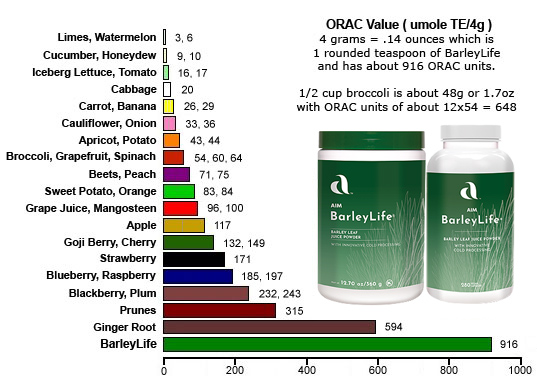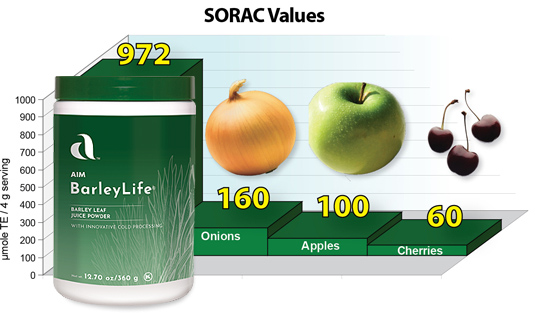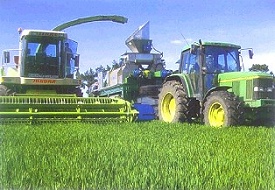|
ORAC - Oxygen Radical Absorbance Capacity ORAC stands for Oxygen Radical Absorbance Capacity. ORAC provides us with a method of measuring the overall antioxidant power of foods and supplements. Antioxidants are essential to good health, especially with respect to aging and age related disorders. Scientists have learned that phytochemicals, including antioxidants, increase our resistance to disease and boost immunity. Hence the recommendation of 5-9 servings of fruits and vegetables each day. Simply put, the higher the ORAC value per equivalent weight of food the more antioxidant power it contains. The focus on "foods" is significant as scientists have found that antioxidants are most effective when received from a whole food. BarleyLife is an awesome whole food quite high in antioxidants. The chart below shows the fruits and vegetables found to be highest in antioxidants. ORAC numbers shown are for 5 grams, the higher the ORAC number, the greater the amount of antioxidants in the food.  ORAC value for foods taken from the 2010 USDA Database for the Oxygen Radical Absorbance Capacity (ORAC) of Selected Foods, Release 2 However ORAC test numbers don't tell the whole story for two reasons. First, the amounts of each food that we typically eat varies from food to food. Secondly, the original ORAC test, used here, only tests foods affectiveness against one free radical, the peroxyl radical. So here are some real life examples, I simply weighed some fruits & veggies that I had on hand, divided by 4 to get the ORAC unit per gram and then multiplied by the items weight in grams. Remember, you have to eat the whole thing not just a slice to get the listed antioxidant. An easy way of increasing your antioxidant intake is to increase your daily BarleyLife intake.
ORAC and TOTAL ORAC FN The original ORAC measures antioxidant capacity against one free radical, the peroxyl radical. However there are five primary free radicals and antioxidant testing has now been developed for all five - peroxyl (ORAC), hydroxyl (HORAC), peroxynitrite (NORAC), singlet oxygen (SOAC), and superoxide anion (SORAC). It makes sense when talking about total antioxidant capacity to include the tests for each of the five major free radicals. Now that these tests are available it will likely take a couple years before sufficient data is available to compare common foods. At the time of this writing we have the SORAC value for BarleyLife, Onions, Apples and Cherries.  3,000 to 5,000 ORAC units per day are required Studies show that the average person gets only about 1200 ORAC units per day from 3 servings of fruits and vegetables. However 3,000 to 5,000 ORAC units per day are required to have a significant impact on plasma and tissue antioxidant capacity. The good news is that each tablespoon of BarleyLife powder contains about 1603 ORAC units! Two tablespoons a day about 3206, three tablespoons 4809 !! Scientists have determined that whole plant foods high in antioxidants are more effective for good health than isolated antioxidant supplements. BarleyLife's antioxidant potency is naturally occurring, NOT artificially inflated through the addition of isolated antioxidants. Another reason why BarleyLife is so good! ORAC Chart for Fruits & Vegetables The first chart above shows a typical ORAC number for fruits and vegetables for 4 grams. Most people take small portions of veggies and fruit, often no more than half a cup which is about 1.7 ounces (48 grams). To get the ORAC number for a 1.7 ounce (48 gram) serving for a vegetable or fruit shown in the chart above, simply multiply by 12. For example, 1.7 ounces of carrots has a typical ORAC value of about 26x10= 260. 1.7oz of broccoli has an ORAC value of around 12x54=648. 1.7oz of Blueberries (about 3/8 cup) would typically provide 1850 ORAC units. The key here is "daily" intake. We highly recommend BarleyLife because children through adults don't come close to getting the suggested 3000-5000 ORAC units per day. In addition to all its other benefits, BarleyLife provides a quick and simple way of making sure your daily whole food antioxidant intake is high enough. ORAC, FREE RADICALS & ANTIOXIDANTS Background - For over 20 years scientists have demonstrated a probable link between various chronic diseases, such as cancer, Alzheimer's disease, rheumatoid arthritis, cardiovascular disease, cataracts, age-related macular degeneration and the actual aging process itself - to free radical damage. Antioxidants, on the other hand, are chemical compounds that have been shown to prevent, stop, or reduce oxidative damage. What is an antioxidant? An antioxidant is any substance that reduces oxidative damage (damage due to oxygen) such as that caused by free radicals. There are hundreds of different antioxidant compounds that include various vitamins, minerals, amino acids, enzymes and phytochemical antioxidants. Since scientists don't know every antioxidant in a plant, a test was developed that indicates the total antioxidant potential. ORAC, what is that? ORAC (Oxygen Radical Absorbance Capacity) is a standardized test adopted by the U.S. Department of Agriculture to measure the Total Antioxidant Potency of foods and nutritional supplements. It provides a very precise way of establishing the Free Radical destroying or neutralizing power of a particular food supplement or compound. Whole foods that score high in an antioxidant assay called ORAC are recognized to protect cells and their components from damage by oxygen radicals. The ORAC standard is necessary because thousands of antioxidants exist in foods making it impossible to measure each individual antioxidant. TOTAL ORAC FN provides an excellent method of determining the overall antioxidant potency of foods. Numerous government and private agencies are now recommending 5-9 servings of vegetables and fruit per day. Why? Scientists have learned that phytochemicals, including antioxidants, increase our resistance to disease and boost immunity. But scientists don't know why phytochemicals seem to lose their disease-fighting powers when they are isolated from the plant (as with antioxidant supplements). Bottom line is God didn't provide us with beta carotene plants, superoxide dismutase plants, vitamin E plants etc. He provided us with plants containing thousands of nutrients that work synergistically in our bodies providing optimum health. The most effective way of getting these powerful antioxidants into the body is from whole plant food sources. Good news on BarleyLife ORAC test results. BarleyLife ORAC and SORAC testing provides another way of saying that BarleyLife is good stuff! Daily use can put you well within the daily-recommended antioxidant intake. Add your daily fruits and veggies and you are at the top of the recommended intake of antioxidants. (Not to mention all the other tremendous nutrients and benefits of the barley juice.) What antioxidants are known to be in BarleyLife? BarleyLife contains numerous substances known to be antioxidants, too many to list here. Some of the largest contributors would be beta-carotene, chlorophyll, superoxide dismutase (SOD)*, catalase, Lutonarin (7-O-GIO), Saponarin (7-O-GIV), Polyphenol oxidase, vitamin E, Phosphorus, and Zinc. Note: These are not ingredients added to BarleyLife but they are naturally occurring nutrients found in BarleyLife. BarleyLife vs Antioxidant Supplements A popular antioxidant supplement on the market today, product X, is advertised as very powerful. So lets compare X to BarleyLife. The ORAC number for X is 3003 TE per gram. Wow! Sounds powerful, right? But remember, the quantity you consume is what determines your antioxidant intake. 1 gram of product X per day would require 17 60mg capsules costing $6.66 ! 4 of the X capsules is a more likely daily dose providing 720 ORAC units at a cost of at least $1.57. BarleyLife however requires only 3.14 grams, or a slightly rounded teaspoon of powder for 720 ORAC units at a cost of less than 40 cents !!! This is very exciting! And BarleyLife is much more than an antioxidant!! ORAC Why is BarleyLife so High in Antioxidants? References: http://www.aces.edu/pubs/docs/H/HE-0778/
BarleyLife information BarleyLife Good Reports BarleyLife Nutrients - Awesome naturally occuring concentrated nutrition BarleyLife - Why BarleyLife Quality is Substantially Better Want to learn more? See the BarleyLife datasheet
|
Hong Kong United Kingdom Other |
Loren & Kathleen Schiele
8733 Fawn Drive
Dallas, TX 75238
Phone: 214-340-0379 or Call Toll Free: 877-735-2121
email: Loren@YourLifeSource.com
Serving You via the Internet since 1996
Copyright © 2013 Loren & Kathleen Schiele -- All Rights Reserved
.
 God made the barley leaf densely nutritious, full of antioxidants. Something man has no idea how to do - God is awesome! Harvesting at the right stage of growth and optimum weather conditions provides the highest antioxidant and overall nutrition content.
God made the barley leaf densely nutritious, full of antioxidants. Something man has no idea how to do - God is awesome! Harvesting at the right stage of growth and optimum weather conditions provides the highest antioxidant and overall nutrition content. 